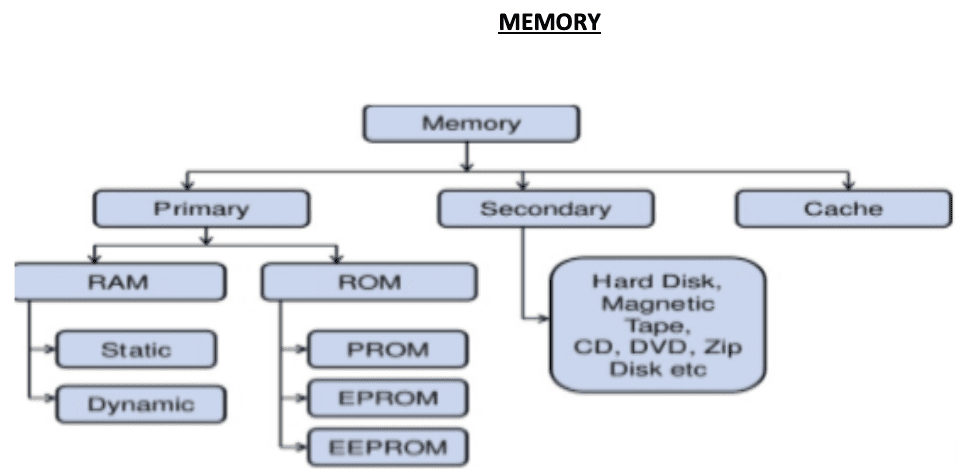
PRIMARY MEMORY OR MAIN MEMORY
Register: Register is one of a small set of data holding places that are part of the computer processor. Register may hold on instruction, a storage address, or any kind of data (such as a bit sequence or individual characters). Some instructions specify registers as part of the instruction.
RAM (Random Access Memory) - Random Access Memory (RAM) is a type of data storage used in computers that is generally located on the motherboard. This type of memory is volatile and all information that was stored in RAM is lost when the computer is turned off.
There are two types of Random Access Memory.
- Dynamic Random Access Memory- Dynamic indicates that the memory must be constantly refreshed (re- energized) or it will lose its contents.
- Static memory- A Computer memory that contains fixed information and retains its programmed state as long as the power is on.
Virtual memory is a feature of an operating system (OS) that allows a computer to compensate for shortages of physical memory by temporarily transferring pages of data from Random Access Memory to disk storage.
ROM (Read Only Memory) - Once data has been written onto a ROM chip it cannot be removed and can only be read. Unlike main memory (RAM), ROM retains its contents even when the computer is turned off. ROM is referred to as being a nonvolatile.
There are three types of Read Only Memory.
- PROM- PROM stands for Programmable read only R this form of ROM is initially blank. The user or manufacturer can write data/program on it by using special devices. However, once the program or data is written in PROM chip, it cannot be changed. If there is an error in writing instructions or data in PROM, the error cannot be erased. PROM chip becomes unusable.
- EPROM- EPROM stands for erasable Programmable read only This form of ROM is also initially blank. The user or manufacturer can write program or data on it by using special devices. Unlike PROM, the data written in EPROM chip can be erased by using special devices and ultraviolet rays. So program or data written in EPROM chip can be changed and new data can also be added. When EPROM is in use, its contents can only be read.
- EEPROM- EEPROM stands for electrically erasable Programmable read only This kind of ROM can be written or change with the help of electrical devices. Show data stored in this type of ROM chip can be easily modified.
CACHE: A cache is a place to store something temporarily in a computing environment. Cache memory, also called CPU memory, is Random Access Memory (RAM).

MEMORY UNITS
Storage capacity is expressed in bytes. The data is represented as binary digits (0s and 1s) Hierarchy- Nibble < bit < byte < KB < GB < GB < TB < PB < XB < ZB< YB
American standard code for information interchange (ASCII) is the standard code the computer industry created to represent characters (more than 64 characters)

SECONDARY MEMORY
Secondary memory is a type of Computer memory that is not directly assessed by the central Processing Unit (CPU) of a computer and is usually available as non-volatile memory. One of the most common forms of this memory is the hard drive of a computer, which is used to store the operating system (OS) and other programs. Other forms of secondary memory include disk drives for compact discs (CDs) or Digital versatile discs (DVDs), as well as removable flash memory.
Hard Drive- A rigid non-removable magnetic disk with a large data storage capacity.
Floppy Disk- A floppy disk, also called a diskette or just desk, is a type of disk storage composed of a disc of thin and flexible Magnetic storage medium, sealed in a rectangular plastic carrier lined with fabric that removes dust particles. Floppy disks are read and written by a floppy disk drive (FDD).
Magnetic Tape- Magnetic tape used in recording sound, pictures, and computer data.
Flash Memory- A kind of memory that retains data in the absence of a power supply.
Optical Disc - An electronic data storage medium that can be written to and read using low power laser beam.
- CD-ROM: "read only" (used for distribution of commercial software). Standard storage capacity is 640 MB.
- CD-R (or CD-WORM): "write once, read many" times
- CD-RW: Rewritable multiple Times
- DVD: Similar to CD, art with significantly large storage capacity (4.7 GB)
- Write once read many (WORM) describes a data storage device in which information, once written, cannot be modified.